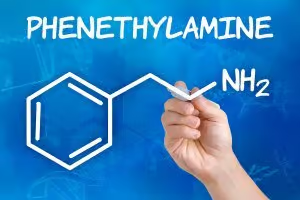Table of Contents
Key Takeaways
- Phenylethylamine (PEA) is a trace amino acid with stimulant and mood-enhancing effects, synthesized from L-Phenylalanine and found in certain foods and chocolate.
- PEA activates TAAR1 and TAAR2 receptors, leading to increased serotonin and dopamine release, potentially helping with anxiety, depression, and ADHD.
- Aging can lead to decreased PEA levels, which may be linked to ADHD, addiction, and neurodegenerative diseases.
- PEA shows promise as an antidepressant and a potential alternative to SSRIs, with ongoing studies for ADHD treatment.
- PEA has a short half-life, which can be extended by using it with a MAO-B inhibitor, and potential side effects include the “cheese effect” and other amphetamine-class side effects.
Phenylethylamine (PEA, 2-phenylethylamine, beta phenylethylamine / β-phenylethylamine, phenethylamine) is a trace amino acid. Your brain naturally converts L-Phenylalanine into Phenylethylamine (PEA).
PEA is not at the top of most nootropic stack choices because its effects are so short-lived. But some neurohackers love PEA for its stimulant and mood enhancing qualities.
The most famous promoter of phenylethylamine was Dr. Alexander Shulgin and his wife Anna. Dr. Shulgin published ‘PiHKAL: A Chemical Love Story’ in 1991. PiHKAL is short for “Phenethylamines I Have Known and Loved”.
Phenylethylamines are a group of phenethylamine derivatives which contain PEA as a backbone. These derivative compounds are formed by replacing one or more hydrogen atoms in the core structure.
This class of PEA compounds include amphetamines, empathogens, stimulants, psychedelics, appetite suppressants, bronchodilators, nasal decongestants, and antidepressants.
One of the more famous PEA derivatives is Methylenedioxymethamphetamine (MDMA or Ecstasy).
Dr. Shulgin developed, tested, and published the formulas for 179 different compounds largely based around the structure of PEA in his book PiHKAL.
In this review we investigate how phenylethylamine (PEA) works in the human brain.
Phenylethylamine helps:
- Anxiety & Depression. PEA activates TAAR1 and TAAR2 receptors which in turn prevents the uptake and boosts the release of the ‘feel-good’ neurotransmitters serotonin and dopamine.
- Neuroprotector. Monoamine oxidase inhibits the catecholamines like dopamine and norepinephrine. Decreases in dopamine levels are implicated in diseases like Parkinson’s. PEA helps boost dopamine and norepinephrine levels. Reducing the symptoms of neurodegenerative diseases.
- Attention Deficit Disorder (ADHD). PEA prevents the reuptake of dopamine and norepinephrine and inhibits their transport. Like the mechanism of action provided by ADHD stimulant meds. Some have found supplementing with PEA as a nootropic has decreased the symptoms of ADHD.
Overview
Phenylethylamine (PEA, 2-phenylethylamine, β-phenylethylamine, phenethylamine) is a trace amine naturally synthesized from L-Phenylalanine in your brain that links to your brain’s trace amine-associated receptor.

Aromatic amino-acid decarboxylase converts phenylalanine to phenylethylamine. This is the same enzyme that converts phenylalanine into dopamine. And it converts it at a rate comparable to the synthesis of dopamine.
But PEA is not retained in neuronal vesicles like dopamine is stored. Instead, monoamine oxidase-B (MAO-B) quickly degrades PEA.[i]
Despite its short half-life, PEA as a nootropic seems to be effective for increasing catecholamine activity by boosting dopamine and norepinephrine.[ii]
PEA can be found naturally in many cacao, algae, fungi, and bacteria as well as clover, beans, peas, and some food products such as Natto and eggs.
PEA is also found in chocolate where it is produced during cacao’s fermentation and roasting process.[iii]
PEA binds to C-protein-coupled receptors TAAR1 and TAAR2, receptors reserved specifically for trace amine use.[iv] These receptors are not used by other major neurotransmitters like dopamine or norepinephrine.
The half-life of PEA taken as a nootropic supplement is only 5 – 10 minutes.[v] Because it’s quickly degraded by monoamine oxidase-B (MAO-B).
Many neurohackers prolong the effects of PEA by using it with a monoamine oxidase-B inhibitor (MAOI) like selegiline (L-Deprenyl), hordenine, or Oat Straw.
How does Phenylethylamine work in the brain?
Phenylethylamine boosts brain health and function in several ways. But two in particular stand out.
- Phenylethylamine decreases depression. PEA naturally boosts the ‘feel-good’ neurotransmitters in your brain called serotonin and dopamine. Studies have shown that depressed patients when tested have lower levels of PEA.[vi]
In fact, some suggest that a PEA deficit may be the cause of depression in the first place. One study had 14 patients with major depression take up to 60 mg per day of Phenylethylamine (PEA) along with 10 mg of selegiline (L-Deprenyl) for up to 50 weeks.
Researchers found that “PEA produces sustained relief of depression in a significant number of patients, including some unresponsive to the standard treatments. PEA improves mood as rapidly as amphetamine but does not produce tolerance.”[vii]
- Phenylethylamine is a mesencephalic enhancer. PEA is considered a mesencephalic enhancer which is defined as “enhancer-sensitive neurons in the brain capable of working in a split-second on a high activity level due to endogenous enhancer substances”.[viii]
This means that PEA stimulates the release of dopamine, norepinephrine, and serotonin in the brain. But unlike stimulant drugs like amphetamine, which release a flood of these neurotransmitters in an uncontrolled manner.
PEA instead only increase the amount of neurotransmitters that get released when a neuron is stimulated by receiving an impulse from a neighboring neuron.
In other words, the pattern of the neurotransmitter release in not changed. But when the neuron would normally release a neurotransmitter, a larger than normal amount is released.[ix]
The result is nearly instantaneous improvements in cognitive performance, attention, awareness, pleasure, libido, and a sense of well-being.
Phenylethylamine is an endogenous (natural or ‘built-in’) amphetamine. This mechanism of action is how prescription ADHD stimulants like Adderall work. And the basis for many Schedule 1 drugs like MDMA[x], LSD, mescaline, and (crystal) methylamphetamine.[xi]
How things go bad
Phenylethylamine (PEA) is naturally metabolized by monoamine oxidase-B (MAO-B). But as we get older, MAO-B levels rise and suppress healthy levels of PEA.
Low PEA levels have been linked to several neurological diseases. And may result in:
↓ Increased chance of ADHD
↓ Increased chance of addiction
↓ Energy levels decline
↓ Working memory and mood decline
↓ Contributing to Parkinson’s Disease
On the other hand, excess levels of PEA has been linked to migraines and paranoid schizophrenia.
Phenylethylamine central nervous system benefits
Phenylethylamine (PEA) quickly crosses the blood-brain barrier once you take it. And you feel its effects right away.
 Activation of TAAR1 receptors inhibit the uptake and induces the release of dopamine, norepinephrine, and serotonin. It’s like turning up the volume of neuron activity.
Activation of TAAR1 receptors inhibit the uptake and induces the release of dopamine, norepinephrine, and serotonin. It’s like turning up the volume of neuron activity.
A higher concentration of all of these neurotransmitters increase feelings of pleasure, boosts motivation, improves memory and cognition, and reinforces impulse control.
PEA naturally maintains and regulates neuronal activity. Preventing over- or under-stimulation. When working as designed, PEA and other trace amines prevent metabolic dysfunction and neurological disorders.
As a neurotransmitter, PEA acts like, and looks similar to amphetamines. And produces effects normally associated with taking a stimulant (like the drug amphetamine Adderall). But unlike amphetamines, and because PEA is endogenous to the brain, side effects and tolerance are avoided.
PEA works in an area of the brain associated with emotions. Resulting in feelings of pleasure, more drive and impulse control, heightened creativity, and better sensory perception.
PEA improves libido, social behavior, a sense of wellbeing, and better overall performance.
PEA is currently being studied and used for the treatment of ADHD, depression, bipolar disorder, cognitive dysfunction like brain fog and poor concentration. And PEA looks promising for treating addiction and eating disorders.
How does Phenylethylamine feel?
PEA is rapidly broken down by monoamine oxidase-B (MAO) so unless you stack PEA with a brain chemical like a MAO-B inhibitor, don’t expect its effects to last. Most experience a peak within 15 minutes and sustained energy for 30 min. to an hour.
If you’re ADHD or ADD, you should see an improvement in mood, attention span, focus and mental clarity. Not quite the same effect you’d get from something like Adderall but with a side benefit of more sociability.
Neurohackers report taking a monoamine oxidase inhibitor (MAOI) supplement 15 minutes before a PEA dose and the effects should last about 2 hours. And there’s no crash like you’d normally experience with a stimulant. Just a general feeling of well-being once it wears off.
Some have reported PEA helped kick the habit of Phenibut or caffeine without going through withdrawal.
As a pre-workout supplement, PEA provides a more intense and focused workout.
Older neurohackers seem to feel even more benefit when using PEA. Likely because monoamine oxidase levels over-power dopamine the older you get. And using PEA, especially with a MAOI helps restore dopamine, the brain chemical called serotonin, and other neurotransmitters that are typically depressed with age.
PEA is a great nootropic for study because you should feel less anxiety, fewer panic attacks and less stress. And more motivation, a better mood, easier to maintain focus, and more energy.
Some report food cravings subside and it’s easier to lose weight.
Phenylethylamine Clinical Research
Phenylethylamine as an Antidepressant
Depression is the 2nd leading cause of disability among ages 15 – 44. By 2030, the World Health Organization predicts depression will be the leading cause of disability worldwide.[xii]
Selective serotonin reuptake inhibitors (SSRI) are the most popular antidepressants prescribed worldwide. SSRIs work by blocking the serotonin transporter and inhibiting the reuptake of the neurotransmitter in your brain called serotonin. Resulting in an increase of serotonin in synapses.
But the problem is SSRIs are slow to act. And come with a host of side effects. The sustained antidepressant effect of Phenylethylamine (PEA) may be an alternative to SSRIs.
A study done in 2008 showed that PEA alters serotonin transporters by interacting with TAAR receptors. Increasing serotonin levels by preventing their reuptake just like prescription SSRIs.
The study suggested that PEA may be a safer treatment for depression than SSRIs.[xiii]
Phenylethylamine for ADHD
The diagnosis of attention deficit hyperactivity disorder (ADHD) has traditionally been done by analysis of symptoms. But measuring PEA levels instead has recently been described as a possible biomarker for diagnosing ADHD.[xiv]
This discovery of a relationship between PEA levels and ADHD has excited researchers. Because it will hopefully improve levels of confidence during ADHD diagnosis. And reduce misdiagnosis and over-medication.
One study of ADHD children medicated with methylphenidate (Ritalin) had significantly higher PEA levels when using methylphenidate.[xv]
PEA binds to the TAAR1 receptor which alters monoamine transporter function. And leads to the inhibition of the reuptake of dopamine, serotonin, and norepinephrine. Which then increases the concentration of these neurotransmitters in neuron synapses.[xvi]
This increase in synaptic concentrations of dopamine can be accomplished by directly blocking the dopamine transporter. Which is how drugs like methylphenidate work to boost dopamine.
So if you are ADHD and crave chocolate, it’s likely because cocao supplies PEA.
Some naturopaths are beginning to prescribe PEA instead of stimulants like amphetamines or methylphenidate to treat ADHD.
Phenylethylamine Dosage
 Phenylethylamine (PEA) suggested dosage for cognitive benefit is 500 mg up to 3-times per day.
Phenylethylamine (PEA) suggested dosage for cognitive benefit is 500 mg up to 3-times per day.
PEA has a half-life of 5 – 10 minutes.[xvii] But the effects of PEA can be extended by using it with a MAO-B inhibitor.
If you do use a potent MAOI like selegiline (l-deprenyl) make sure you keep the dose low (i.e. 2.5 mg) or you’re in danger of inhibiting MAO-A as well. More on the “cheese effect” next.
Dosing more than recommended is NOT a good idea because you’ll likely feel jittery, irritable, get a headache, feel nausea, and very possibly force your heart rate to dangerous levels.
Phenylethylamine Side Effects
“Cheese effect”: Phenylethylamine (PEA) is metabolized by the enzyme MAO-B. And when monoamine oxidase (MAO) is inhibited by eating cheese, or any other prescription or natural MAO inhibitor (MAOI), the combination can result in a potentially dangerous increase in blood pressure.[xviii]
Studies show that selective MAO-B inhibition does NOT produce this cheese effect.[xix]
Examples of MAO-B selective inhibitors include low-dose selegiline (L-deprenyl), hordenine, Polygala Tenuifolia, Oat Straw, Glycyrrhiza uralensis (Chinese licorice root extract), Phellondendron amurense (Amur cork tree bark), Ferula assafoetida extract (resin), and Psoralea corylifolia (Bu Gu Zhi).[xx]
Do not use Phenylethylamine (PEA) if you are using a prescription MAOI like Marplan, Nardil, Azilect or Parnate, or have used one in the last 14 days.
Do not use PEA if you have phenylketonuria (PKU).
Too much PEA can cause irritability, nausea, amplified heart rate, jitteriness, and could be extremely dangerous.
Remember, Phenylethylamine (PEA) is a (natural) endogenous amphetamine. And used irresponsibly could produce the same dangerous side effects as anything else in the amphetamine-class of compounds.
Where to buy Phenylethylamine
Phenylethylamine (PEA) is available in capsules, tablets, and as a bulk powder.
DO NOT make the mistake of buying Phenylalanine instead of Phenylethylamine (PEA). Because it’s NOT the same thing. And is easily overlooked when searching for this nootropic.
You can buy Phenylethylamine in powder form from Bulk Supplements.
If you buy PEA in powder-form, you should invest in a capsule machine and make capsules. Because PEA is a particularly nasty tasting nootropic supplement.
Nootropics Expert Recommendation
 Phenylethylamine 500 mg up to 3-times per day
Phenylethylamine 500 mg up to 3-times per day
I recommend using Phenylethylamine (PEA) as a nootropic supplement.
Your body does synthesize some Phenylethylamine from phenylalanine which comes from foods like beans, cacao, peas, Natto and eggs.
But most of us don’t get enough Phenylethylamine from our diet. So supplementation could help. Phenylethylamine is highly bioavailable, and quickly crosses the blood-brain barrier. So you should feel its effects soon after you take it.
Phenylethylamine is helpful for most neurohackers to combat anxiety, stress, and sleep deprivation. It’ll boost dopamine, norepinephrine, and serotonin levels.
It’s particularly helpful if you take Phenylethylamine prior to a stressful situation, workout, or physically demanding job. And it’s a great nootropic for studying.
Phenylethylamine could be helpful to those dealing with ADHD/ADD. It’s a possible substitute to stimulant meds like Ritalin or Adderall for some people.
PEA will provide the dopamine your brain needs. And doesn’t produce the stimulant crash when it wears off.
PEA works well when stacked with L-Tyrosine (for dopamine), and CDP-Choline and ALCAR (for acetylcholine).
PEA is quickly degraded by monoamine oxidase-B. So to prologue its effects, stack it with a low-dose MAOI-B.
You can buy Phenylethylamine in powder form from Bulk Supplements.









Join The Discussion - 188 comments
Rhett
February 7, 2025
Hey David, what dosages would you recommenced with PEA and Hordenine? Not sure if you mentioned it or not.
Thanks,
Rhett
David Tomen
February 12, 2025
Rhett, 100 mg Hordenine or less about 20 minutes before taking PEA. Check the guys on Reddit and see now much they use.
Nathan Smeltzer
December 14, 2024
Hi David. Do you have a source or any names for the following:
“Some naturopaths are beginning to prescribe PEA instead of stimulants like amphetamines or methylphenidate to treat ADHD.”
I’ve been taking PEA several times daily and it helps on days I’m not taking Adderall. I’m curious to see who else might be suggesting this.
David Tomen
December 16, 2024
Nathan I can’t remember where I saw that reference to “naturopaths”. But that is not something I would have pulled from thin air. I likely came across that comment in a clinical study somewhere. Or read it in ‘PiHKAL: A Chemical Love Story’ by Dr. Shulgin.
Rhett
December 9, 2024
Hi David,
Thanks again for the information you provided. I’m trying to ensure I’m understanding everything correctly. My neurotransmitter test showed that both my Tyrosine and Dopamine levels were within the optimal range. However, my PEA levels were on the lower end. Can you help me understand why this might be?
I feel like my diet is solid, and I do supplement with a small amount of L-Tyrosine. For context, I also have ADD. With that in mind, do you think I should consider taking PEA? The lab’s Therapeutic Considerations suggested B6 and Phenylalanine, and they also mentioned that Curcumin and Passionflower (botanical MAO inhibitors) might be beneficial to prevent rapid metabolism.
I’d appreciate any insight you can provide.
Thanks
David Tomen
December 16, 2024
Rhett, I highly recommend not counting those labs for tyrosine and dopamine to be accurate. There is no way to measure either of those in your brain. What is found in your blood is not helpful.
Please see my article on Best Nootropics for ADHD to see my protocol for taking care of this issue: https://nootropicsexpert.com/best-nootropics-for-adhd-add/
Michael
November 17, 2024
Hi David I’ve recently discovered PEA through its relation to phenylalanine my new favorite supplement. I suffer from adhd and depression both which phenylalanine does wonders to treat.
My question is, I have some PEA I’m interested in experimenting with as well as oat straw for the Mao-b inhibition. I’m very nervous about over doing the PEA dose. do you have any recommendations for dosing this combination?
I’m male 195lbs
I have tried 400mg oatstraw followed by 600mg PEA and noticed very little to no effect (warm, tingles, increased heart rate) could be placebo. What dose do
You recommend?
P.S is kava kava tea a concern for additional mao-b inhibition? I regularly consume kava.
David Tomen
November 23, 2024
Michael, it depends on how good your Oat Straw extract is so it’s difficult to recommend the right dose. But scroll back up to the section where I talk about other natural MAOIs. You might need to use more than one. Try adding https://nootropicsexpert.com/polygala-tenuifolia/ and see if that helps.
Nancy
October 12, 2024
Is it safe to mix PEA with d/l-Phenylalanine? I take the Phenylalanine to help with adhd and I would like to add PEA to see if it will help my peripheral neuropathy.
David Tomen
October 15, 2024
Nancy, there should not be a problem. But you may need to adjust your dosage for each depending on how you react to using both.
Scott
October 1, 2024
Hi David,
I have been experimenting with PEA for a few weeks and love it. By combining with 2.5mg selegiline the effects are nice and tight for 3-4 hours. I am reading about other MAO-B inhibitors and wonder if you have an opinion on whether low dose selegiline, hordenine, oat straw, or something else works best to potentiate PEA. Which is most effective? Safer? Healthier?
And BTW, I looked at some of the bioavailability and first pass metabolism data vs no first pass (intranasal) and made a nasal spray our of it. It is soluble in water, so I used bacteriostatic water as a vehicle and started low, at 10mg/spray, taking 2 sprays PEA after taking selegiline. Then I bumped it up to 20mg/spray, taking 2 sprays. That seems to be a sweet spot. I like the idea of intranasal with much smaller doses to cut down on how much work my liver has to do in general. 40mg intranasal vs 500mg oral for the same effect. I want to keep my liver healthy. Also, I am doing the same thing with Noopept, but I didn’t have to do the research and math, since science.bio sells a Noopept nasal spray, 1mg/spray – much lower than the usual oral dose, and again, liver friendly. I look forward to your opinion about the MAO-B potentiators. And Head First is AMAZING. A really, really great reference for us psychonauts to help with the trial and error and potential dangers of self-experimentation.
Best, Scott
David Tomen
October 2, 2024
Scott, thanks for your comment about my book Head First. Much appreciated. Oat Straw extract is arguably the safest natural MAOI. Neuravena® is a good option if you want to try it. Life Extension has it in this supplement: https://geni.us/nSdMC
Damon Dibbet
October 3, 2024
Hi David What do You Recommend for Vyvanse or Short Acting Dexampfetamine I Hear That DL-Phenyallanine Works Better than L-Tyrosine For Vyvanse Or Dexerdrine Because DL-Phenyallanine Makes PEA What are your Thoughts David I like to Hear From You
David Tomen
October 3, 2024
Damon, your brain naturally converts L-Phenylalanine into Phenylethylamine (PEA). But I’ve only every recommended L-Tyrosine 500 mg 2 or 3-times per day when using an ADHA stimulant. A very few prefer Phenylalanine over L-Tyrosine. So whichever works better for you. The only way to find out is test each one for a week or two and see which one feels better for you.
Scott
August 16, 2024
Hi David.
I understand the 5-10 min half-life of PEA. However, does the research show clinical/cognitive effects going beyond that? ie, if PEA is inhibiting the reuptake of monoamines for 5, 10, 15 minutes, is there a downstream clinical effect that lasts longer by virtue of what it did in those few minutes? Or is it more like, 5-10 min exposure to PEA = 5-10 min cognitive enhancement.
Thx. And thx for all the good work you do on behalf of so many of us trying to live a better life!
Scott
David Tomen
August 19, 2024
Scott, 5-10 min exposure to PEA = 5-10 min cognitive enhancement. That is why people use it with a MAOI to prolong that benefit.
duncan moss
July 26, 2024
Could you combine cbd and pea ?
David Tomen
July 26, 2024
CDB Oil is not contraindicated with anything.
Russell Baker
November 10, 2024
CBD inhibits cyp2d6 as do amphetamines and SSRIs and many other drugs. so does other herbs . sulforaphane by 7i%,. that day my q0mg of dextroamphetamine laster all day.